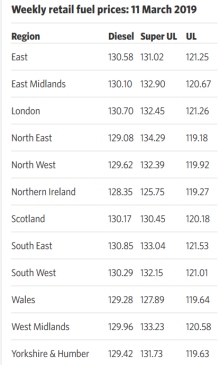
See our charts
for petrol, diesel and Brent crude prices

Download
the charts
How much tax is
there in a litre or tank of petrol?

|
Will we see
forecourt prices rising?
Since November 2018 the average price of unleaded petrol went
down by 10.5 p/litre, falling from 130.1 p to 119.6 p by the
end of January 2019. The cost of diesel also dropped, by 7.3p
per litre to 128.9 p. Crude oil production cuts made by OPEC
(Organisation of the Petroleum Exporting Countries) in partnership
with Russia have driven up the price of crude oil by 5%. This
added US$3 to the barrel price during February 2019 moving
the price to US$65.13 by the end of the month. At one point,
the price of a barrel reached US$67- the highest it’s
been since November 2018.
But prices
are turning. After over six weeks of keeping its forecourt
prices the same, Asda was the first supermarket of "the
big four" in the UK to pass the rise in wholesale prices
on to its customers with a slight increase in the price of
its unleaded petrol. An average 60 litre family car now costs
just over £70 to fill up with petrol.
"Rocket and feather" feature of the motor fuel
market
RAC Media
Relations Manager and fuel spokesman, Simon Williams, said
the price rise would disappoint drivers but “what they
probably aren’t aware of is that retailers, who held
off cuts for weeks when they were warranted, instantly raised
their prices when they saw the wholesale price go up very
slightly”. He added that this was “clear proof of
the infamous ‘rocket and feather’ pricing strategy
where prices go up like a rocket and fall like a feather.”
The forecourt industry denies making good profits from petrol
sales and it’s true that most retailers make only a little
on a litre of fuel; often just one or two pence profit per
litre. “That is hardly sustainable,” said Brian
Madderson, Chairman of the Petrol Retailers Association (PRA),
in the past when defending earlier prices rises. He explained
the only way most petrol stations survive is by having other
facilities attached to them, such as shops, car washes and
cash machines. Mr Madderson added: “If they were making
substantial margins, we would see more investment coming into
the business, rather than going out of it.”
Saving
you money
Even though a driver can’t control the price of petrol
and diesel, it’s possible to reduce how much you use.
Figures by the Department for Transport show we use up to
9% more fuel driving at 70mph than at 60mph and up to 25%
more fuel travelling at 80mph instead of 70mph. The faster
you drive, the greater your fuel consumption.
The most energy-efficient way of driving is a smooth use of
the throttle. Focus on what’s ahead so you can make adjustments
early to prevent a disruption to your flow. Another economy
factor is weight - on
average, every extra 50kg of weight in the car increases fuel
consumption by 2%, so don’t keep unnecessary items in
your boot and only fill up the fuel tank halfway if you’re
an urban driver. Don’t leave your roof racks on as they
cause ‘drag’. Even empty roof racks increase fuel
consumption by around 10%.
|






